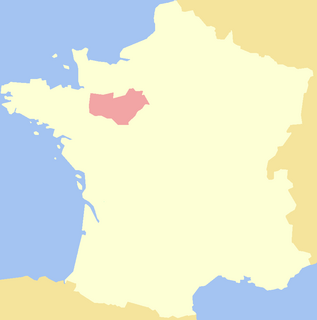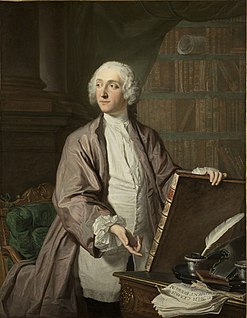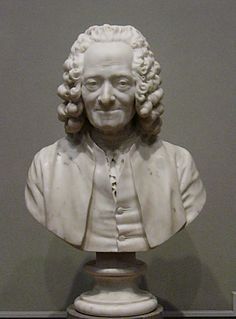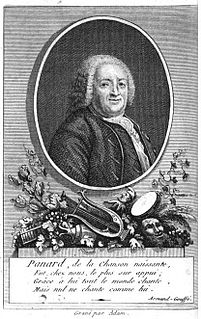Biography
Louis-François-Henri de Menon was born in a distinguished family from Anjou, which had acquired an estate in the province of Anjou by marriage in the 14th century. [1] De Menon took his studies at the college of the Jesuits of La Flèche.

Anjou is a historical province of France straddling the lower Loire River. Its capital was Angers and it was roughly coextensive with the diocese of Angers. It bordered Brittany to the west, Maine to the north, Touraine to the east and Poitou to the south. The adjectival form of Anjou is Angevin, and inhabitants of Anjou are known as Angevins. During the Middle Ages, the County of Anjou, ruled by the Counts of Anjou, was a prominent fief of the French crown.

La Flèche is a town and commune in the French department of Sarthe, in the Pays de la Loire region in the Loire Valley. It is the sub-prefecture of the South-Sarthe, the chief district and the chief city of a canton, and the second most populous city of the department. The city is part of the Community of communes of the Pays La Flèche. The inhabitants of the town are called the La Flèchois. It is classified as a country of art and history.
Military career
After his studies he entered the regiment of Normandy in 1733. During the War of the Polish Succession, he distinguished himself at the Siege of Philippsburg in 1734.

The War of the Polish Succession (1733–35) was a major European war sparked by a Polish civil war over the succession to Augustus II, which the other European powers widened in pursuit of their own national interests. France and Spain, the two Bourbon powers, attempted to check the power of the Austrian Habsburgs in western Europe, as did the Kingdom of Prussia, whilst Saxony and Russia mobilized to support the eventual Polish victor. The slight amount of fighting in Poland resulted in the accession of Augustus III, who in addition to Russia and Saxony, was politically supported by the Habsburgs.

The Siege of Philippsburg was conducted by French forces against forces in the fortress of Philippsburg in the Rhine River valley during the War of the Polish Succession. The Duke of Berwick led 100,000 men up the Rhine Valley in opposition to Austrian forces, of which 60,000 were detached to invest the fortress at Philippsburg, beginning on 1 June 1734. A relief column of 35,000 under the aging Prince Eugene of Savoy was unsuccessful in actually relieving the siege. On 12 June Berwick was killed by a cannonball while inspecting the trenches, and command of the besiegers fell to Marshals d'Asfeld and Noailles. The fortress surrendered one month later, and the garrison withdrew to the fortress of Mainz with the honours of war.
Made captain in 1737, he was assigned to cavalry regiment from Roussillon in 1740. After the death of his father in 1737, he became landowner of a considerable estate, where he began making great improvement by rationalising the work. In the War of 1741 recalled to his regiment, leaving his estate in the hands of a capable manager.

Roussillon is one of the historical counties of the former Principality of Catalonia, corresponding roughly to the present-day southern French département of Pyrénées-Orientales save Fenouillèdes. It may also refer to Northern Catalonia or French Catalonia, the first used by Catalan-speakers and the second used by French-speakers. A 1998 survey found that 34% of respondents stated they speak Catalan, and a further 21% understand it.
During the War of the Austrian Succession, de Menon fought in Bohemia, in Westphalia, and eventually integrated into the Regiment of Saxony. He received the Order of Saint Louis before attending the sieges of Antwerp and Brussels, and the Battle of Rocoux. Seriously wounded in the Battle of Lauffeld in 1747, he had to leave the army.

The War of the Austrian Succession involved most of the powers of Europe over the issue of Archduchess Maria Theresa's succession to the Habsburg Monarchy. The war included peripheral events such as King George's War in British America, the War of Jenkins' Ear, the First Carnatic War in India, the Jacobite rising of 1745 in Scotland, and the First and Second Silesian Wars.

Bohemia is the westernmost and largest historical region of the Czech lands in the present-day Czech Republic. In a broader meaning, Bohemia sometimes refers to the entire Czech territory, including Moravia and Czech Silesia, especially in a historical context, such as the Lands of the Bohemian Crown ruled by Bohemian kings.

Westphalia is a region in northwestern Germany and one of the three historic parts of the state of North Rhine-Westphalia. It has an area of 20,208 km2 (7,802 sq mi) and 7.9 million inhabitants.
Agriculture


Louis-François-Henri de Menon retired to his estates in the South of Mayenne, in the province of Anjou, in the commune of Villiers-Charlemagne. He is known for his dissertation on the deforestation. Of the inherited estate, an area located in Baugé about 1000 hectares, in 1737 most of which was still uncultivated. He improves the land by clearing (removal of forest), and adding drainage, turing it into a model estate. He cleared the heather, that covered most of the land around the town of Villiers, and created pathways to make the land more productive. Forty years later his territory had become one of the richest in the province.
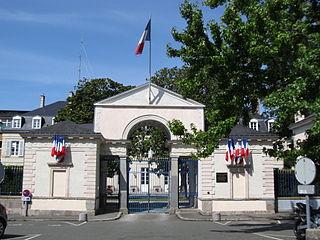
Mayenne is a department in northwest France named after the Mayenne River. Mayenne is part of the current region of Pays de la Loire and is surrounded by the departments of Manche, Orne, Sarthe, Maine-et-Loire, and Ille-et-Vilaine.

Villiers-Charlemagne is a commune in the Mayenne department in north-western France.

Deforestation, clearance, clearcutting or clearing is the removal of a forest or stand of trees from land which is then converted to a non-forest use. Deforestation can involve conversion of forest land to farms, ranches, or urban use. The most concentrated deforestation occurs in tropical rainforests. About 31% of Earth's land surface is covered by forests.
He became friend and adviser to the minister Bertin. He inspired a circular initiated 22 August 1760, in which people were invited to create Agricultural societies. [2] He also influenced the decision of the French Parlement of 16 April 1761 in favour of deforestation. He was elected fellow of the Royal Society, 22 April 1762 under the name Francois-Henri, Marquis de Turbilly. [3]
He initiated two awards for the best and most beautiful wheat and rye harvested in the commune. The awards consist of a sum of money and a medal. It was the first of its kind given in France. Another of his ideas was the establishment of agricultural societies in the country. Another of his ideas was to abolish the practice of begging, on which he succeeded in his lands.
De Menon also develops new activities such as the cultivation of hemp; the rearing of silkworms for the production of silk; and a small factory for the production of soap and another unit for the production of terracotta roof tiles. Towards the end of his life he initiated fish farming. His latest project to produce porcelain turned into a legal and financial nightmare. His large enterprises had asked immense capital. Some of its operations did not succeed in the first years, and eventually he got totally ruined. [1] While the creditors were seizing his property, De Menon had turned over his administration just before his death in Paris on 25 February 1776.
